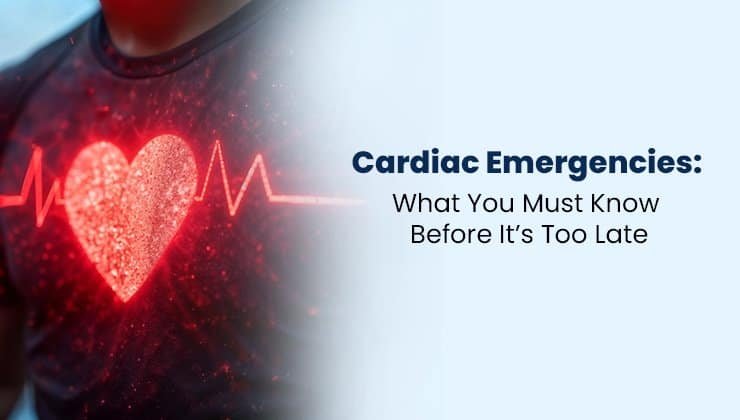Cardiac emergencies are sudden, life-threatening problems that affect how the heart functions and require immediate medical attention. It includes heart attack, cardiac arrest, aortic dissection, and arrhythmias. Understanding the causes, risk factors, warning signs, and prevention is necessary to prevent unwanted complications and save lives.
Keep reading to learn more about different cardiac emergencies, their causes, symptoms, and how to prevent them!
Understanding Cardiac Emergencies
Cardiac emergencies are critical situations in which the ability of the heart to pump blood is impaired and may be lethal if left untreated. It can occur when the heart is not getting enough oxygen, beats in an irregular rhythm, or stops beating completely.
Common conditions that may cause a cardiac emergency include heart attacks, cardiac arrest, and arrhythmias. Prompt recognition and medical intervention are essential to improve survival rate.
Types of Cardiac Emergencies
The most common cardiac emergencies include
- Heart attack: Blood flow is blocked to the part of the heart, causing damage.
- Cardiac arrest: The heart stops beating suddenly
- Heart failure: The heart loses its ability to pump blood efficiently
- Aortic dissection: Internal bleeding due to tear in the aorta
- Cardiac tamponade: Fluid builds up around the heart
Causes Of Cardiac Emergencies
The different causes of cardiac emergencies are
- Blocked or narrowed heart arteries
- High blood pressure
- Heart muscle damage
- Arrhythmias
- Overdose of drugs
- Severe chest infections
- Trauma to the chest
Signs And Symptoms Of Cardiac Emergencies
The warning signs for different cardiac conditions may vary. However, the common signs and symptoms to watch out are
- Chest pain or discomfort characterized as a squeezing, pressure, or fullness in the chest
- Breathing difficulties
- Lightheadedness
- Nausea or vomiting
- Unexplained sweating sometimes referred to as cold sweat
- Palpitations or irregular heartbeats
If someone shows these symptoms, call a medical emergency immediately.
Risk Factors Of Cardiac Emergencies
The different risk factors that may increase the risk of developing cardiac emergencies, include
- Age and gender
- A family history of developing heart disease
- Presence of chronic conditions, including diabetes, high cholesterol, and obesity
- Poor lifestyle choices, including excessive alcohol consumption, smoking, poor diet, and sedentary lifestyle
- Chronic stress or anxiety
Diagnosis Of Cardiac Emergencies
Pay close attention to different symptoms including deep chest discomfort, troubled breathing, abnormal or fast heartbeat, lightheadedness, and fainting. Few people may experience pain radiating to their jay, necks, arms, or back.
If you notice these signs, it is crucial to seek prompt medical attention. Healthcare professionals may conduct different tests, including
- Electrocardiogram to identify the abnormal electrical activity of the heart
- Blood testing to look for signs of heart damage
- Chest X-ray to identify the fluid in the lungs
- Stress tests to evaluate the response of the heart to the physical stress
- Cardiac MRI to diagnose complex cardiac problems
What To Do During A Cardiac Emergency?
The steps to be followed when a person is experiencing a cardiac emergency are
- Call emergency services: If someone shows the signs of cardiac emergency, call the local emergency number and ask for help
- Perform CPR: Check if the person is breathing. If the individual is not breathing, start CPR if trained. You may use an Automated External Defibrillator (AED) if available
- Give aspirin: If the person is awake, help them sit comfortably, keep the person calm and give aspirin when required. Wait until the help arrives.
Treatment Of Cardiac Emergencies
The treatment for cardiac emergencies may vary depending on the particular disease and it usually involves the following medical interventions, including
- Medications, including beta-blockers, anticoagulants, antiplatelet medications, and other drugs are commonly used to stabilize the heart
- Defibrillation is required for survival during cardiac arrest.
- Immediate CPR may be required to sustain blood circulation and deliver oxygen to important organs.
- Angioplasty and stent may be required to open the clogged arteries and restore the blood supply to the heart during or after a heart attack
- Coronary artery bypass surgery may be required when numerous coronary arteries are blocked and helps in restoring the blood flow to the heart muscle.
- Pacemakers may be implanted to regulate abnormal heart rhythms.
These medical interventions may help in saving lives, minimizing complications, and improving the overall outcomes.
Prevention And Lifestyle Modification Of Cardiac Emergencies
Different measures that may be taken to reduce the risk of cardiac emergencies include
- Regular check-ups: Have routine health check-ups to identify risk factors and receive an early diagnosis of cardiac disease. Adhere to prescribedmedicines.
- Manage other conditions: Identify and control underlying medical conditions, including high blood pressure, diabetes, and high cholesterol.
- Practice heart-healthy lifestyle: Maintain a healthy lifestyle by avoiding tobacco products, limiting excessive alcohol consumption, managing chronic stress, and exercising regularly. Follow a nutritious diet focusing on whole grains, lean proteins, fruits, vegetables, and fats.
Conclusion
Cardiac emergencies are dangerous life-threatening conditions. Recognising the signs and symptoms may help in prevent complications and save lives. Following a heart-healthy diet, getting regular check ups, exercising regularly, and quitting smoking may reduce the risk of cardiac emergencies.
If you or loved one are experiencing symptoms of a cardiac emergency, feel free to book an appointment with Dr Nikhil of Heart360 Care for early diagnosis and personalised treatment regimen best suited to your needs!
Frequently Asked Questions
A cardiac emergency may present as sudden chest pain, difficulty in breathing, collapse or fainting, sudden dizziness, irregular heart beat, and pain in the arm, jaw or back. If someone shows these symptoms, call emergency services and begin CPR if the person is unresponsive or not breathing to avoid complications.
If someone shows signs of cardiac emergencies, call emergency services immediately. If the person is unresponsive and not breathing, you may start CPR if you are trained. You may use an AED if available. Stay calm and remain with the person until the help arrives.
Yes, young people may have cardiac emergencies but it is less common. It may occur due to different factors, including undiagnosed genetic conditions, drug overuse, or extreme physical stress. Regular check-ups and monitoring of symptoms may help in detecting cardiac problems in younger individuals.
Few studies have shown that patients with chronic stress-related disorders and anxiety are at the increased risk of developing cardiac diseases. It may raise blood pressure, cause irregular heartbeats, or lead to a heart attack in a few cases. More studies in the future are required to determine the effect of stress and cardiac emergencies.









